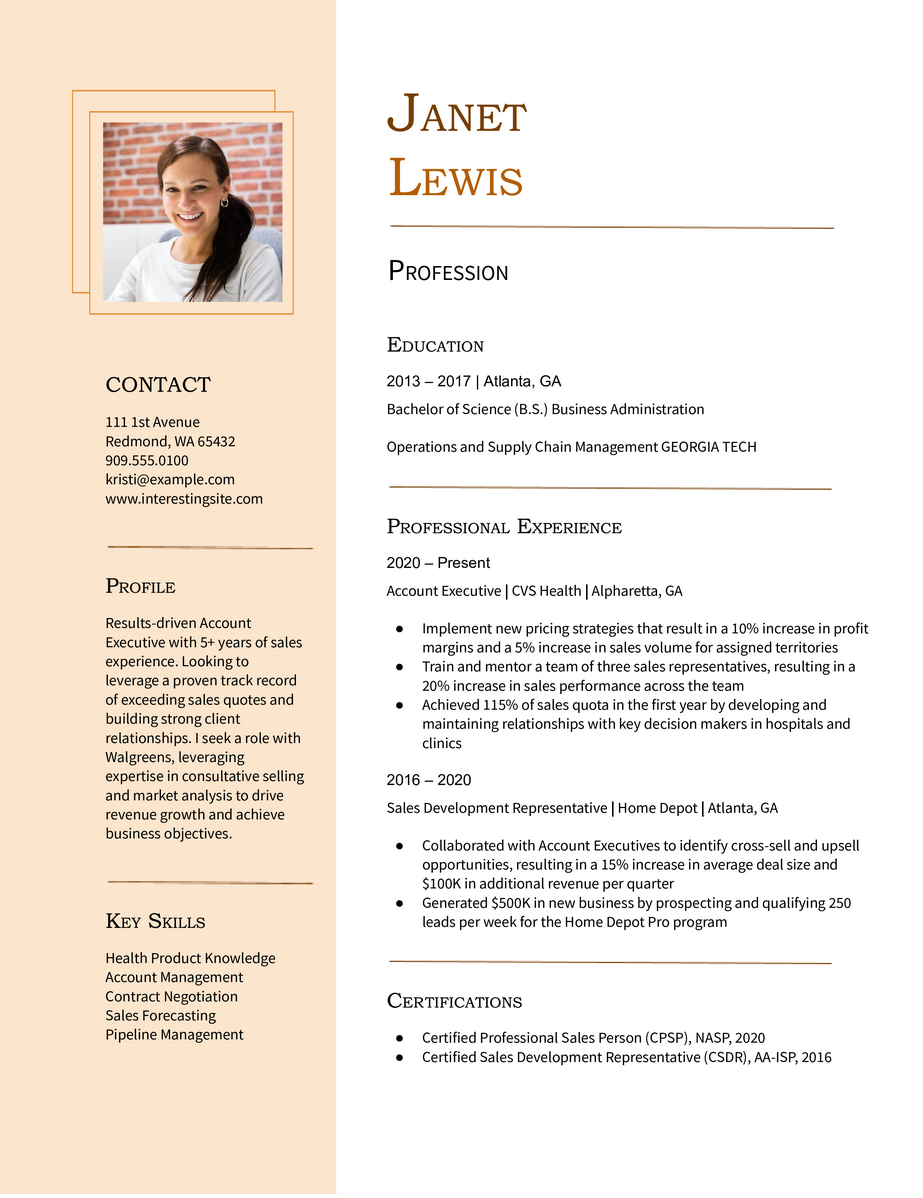- How Long Should a Resume Be? One Page vs. Two Pages
- Pros and cons of a one-page resume
- When To Use a One-Page Resume vs. a Two-Page Resume
- Tips for Keeping a Resume to One Page
- Structuring a Two-Page Resume Effectively
- Examples of One-Page vs. Two-Page Resumes for Different Career Levels
- Common Mistakes To Avoid When Deciding on Resume Length
- Frequently Asked Questions About Resume Length
How Long Should a Resume Be? One Page vs. Two Pages
Most job seekers are concerned about the perfect resume length. Some cram everything onto one page because they hear it must be no longer that. And others have no regard for length and overwhelm recruiters. There is no one-size-fits-all answer when it comes to resume length.
We’ll break down the difference between a one-page and two-page resume, provide tips for applicant tracking system (ATS) optimization, and offer layout strategies for every career stage. Whether you’re a recent grad, a mid-level professional, or an executive with years of experience, this comprehensive guide has you covered. Plus, we’ll share actionable examples so you can create a polished resume that gets noticed.
Why resume length matters:
Resume length matters because recruiters spend a few seconds scanning your resume for critical pieces of information. If your resume makes it difficult for them to find this information, they’ll likely skip it and move on to the next application.
The goal of your resume is to get the interview, so while listing out every single thing you’ve ever accomplished seems like it will make you a better candidate, it’s usually better to list only the information that will lead to an interview, and leave the rest for the actual interview. Often, this means only including information that will help an employer envision you in their role using specific, measurable results.
Pros and cons of a one-page resume
Advantages of a one-page resume
Quick scans: Recruiters appreciate short resumes because they can rapidly assess your qualifications without wading through irrelevant details. They’ll likely thank you with an interview invite if you can make their job easier with a “straight-to-the-point” resume.
ATS-friendly: Compact formats with clear headers and bullet points are easier for ATS software to process. While employers use different ATS, it’s safe to assume they’re looking for more straightforward resume templates.
Focused content: A one-page resume requires prioritizing your most relevant skills and experiences, creating a stronger impression. The more information you attempt to add to a resume, the more they have to read, and the chances of it being read decrease. Even though it feels counterintuitive, a more concise feel is usually better.
Disadvantages of a one-page resume
Once you have more than two roles and a few years of experience, it becomes difficult to fit all the information onto one page.
For mid- to senior-level candidates, it’s acceptable to have your resume flow onto a second page so that there is space for more experience and information. That’s why most advice says that one-page resumes are easier for new grads.
When To Use a One-Page Resume vs. a Two-Page Resume
Entry-level and recent graduates
A one-page resume is ideal for recent grads or those with less than five years of experience. Highlight your education, internships, relevant coursework, and extracurricular achievements. Focus on tailoring your resume to the specific job description.
Mid-level professionals with 5 to 10 years of experience
If you have a diverse work history, a two-page resume might be necessary to highlight key accomplishments. Use the second page to expand on achievements and projects that align closely with the role.
Senior professionals and specialized roles
If you have held more than two to three roles, it might be challenging to fit your experience onto one page. There are also specialized roles like education, where longer resumes are usually standard.
Tips for Keeping a Resume to One Page
Prioritize relevant information
Employers want information to help them envision you on their team. To help them, illustrate what you’ve done regarding time, money, and scope. Rather than listing your daily task list, think about cash made, saved, or managed. Did it impact the immediate team, or have global reach?
Using numbers, percentages, and timeframes is best for building a strong resume. If the information you have isn’t tied to a metric, it can be removed or replaced. Every role has an impact.
Need ideas of what to put on a resume? Here are tips on content prioritization.
Use a professional, ATS-friendly format
Choose layouts that maximize space using clear headers, concise bullet points, and consistent spacing. Avoid unnecessary design elements that could interfere with ATS processing.
Quantify achievements concisely
You can use numbers to express several things throughout your resume. Utilize it to summarize your background, team size, budget, money made or saved, and timeframes. Numbers make your accomplishments stand out without lengthy explanations. For example:
- “Increased sales by 20% over six months.”
- “Managed a $500,000 budget for marketing campaigns.”
- “Recruited 30 new team members from June 2023 to December 2024
Optimize with action verbs and keywords
Starting your bullet points with strong action verbs like led, implemented, or achieved will strengthen your resume. It’s always good to vary the verbs used to appear manageable.
Structuring a Two-Page Resume Effectively
Balancing content across pages
Keep the most important information on page one. Ensure your contact information, professional summary, and top achievements are front and center on the first page.
Things like older roles, education, tools, and certifications can be included on the second page or at the bottom of the first page.
Using headers and white space for readability
Organize your resume with clear section headers and enough spacing to make it visually easier to scan and help the recruiter quickly find what they are looking for.
Adding lots of white space allows the reader to digest your resume more efficiently, rather than cramming everything onto one page. If you find yourself doing that, having a two-page resume is a good idea.
Including contact information and a summary on both pages
Contact information was more prevalent when resumes were printed, so the second page was noticed during the intervals. However, with most resumes and hiring practices being virtual, there’s no need to waste space by including your contact information on the second page. Use this space intentionally to provide the employer with more information about your background.
Examples of One-Page vs. Two-Page Resumes for Different Career Levels
Example 1: Entry-Level One-Page Resume
Compact layout focusing on skills, education, and internships
Maria Lopez [email protected] | (555) 123-4567 | Miami, FL 33101
Profile
Recent college graduate with a Bachelor of Science in Marketing. Skilled in social media management, email marketing, and data analysis. Experienced in supporting marketing campaigns through internships and academic projects, with a passion for driving brand awareness and audience engagement.
Key Skills
- Social media marketing
- Email campaign management
- Google Analytics
- Content creation
Education
Bachelor of Science (B.S.) in Marketing University of Miami, Miami, FL
Professional Experience
Marketing Intern Bright Futures Agency, Miami, FL | January 2023 – May 2023
- Assisted with creating and scheduling social media posts, increasing engagement by 18%
- Supported the team in email marketing campaigns, achieving an average open rate of 22%
Example 2: Mid-Level Two-Page Resume
Structured layout for professionals with five to 10 years of experience, featuring core skills and achievements on the first page
David Chen [email protected] | (555) 987-6543 | Seattle, WA 98109 | LinkedIn
Profile
Digital marketing specialist with over six years of experience managing comprehensive marketing campaigns for SaaS companies. Proven success in increasing lead generation, optimizing SEO strategies, and driving customer engagement through data-driven initiatives.
Key Skills
- SEO strategy
- Marketing analytics
- Conversion rate optimization
- Paid advertising campaigns
Professional Experience
Digital Marketing Manager Evergreen Software, Seattle, WA | May 2018 – Present
- Managed paid search campaigns, generating $1.5 million in additional annual revenue
- Implemented SEO strategies that increased organic traffic by 35% over 12 months
- Collaborated with cross-functional teams to launch three product campaigns, driving a 20% rise in customer acquisition
Marketing Specialist Tech Solutions Co., Seattle, WA | January 2016 – May 2018
- Supported the development of content marketing strategies that improved lead generation by 28%
- Created email drip campaigns, achieving a 25% open rate and a 5% click-through rate
Education
Bachelor of Arts (B.A.) in Communication, University of Washington, Seattle, WA
Example 3: Senior-Level or Technical Two-Page Resume
Layout featuring in-depth project descriptions, technical skills, and leadership experience
Alan Richards [email protected] | (555) 567-8901 | Boston, MA 02110 | LinkedIn | Portfolio
Profile
Senior software engineer with over 15 years of experience leading large-scale projects in machine learning, software architecture, and cloud computing. Skilled in team leadership and delivering high-impact, scalable solutions. Adept at cross-functional collaboration and project management for enterprise-level applications.
Key Skills
- Cloud architecture
- Machine learning models
- Agile development methodologies
- Software project management
Professional Experience
Principal Software Engineer InnovateTech Solutions, Boston, MA | January 2015 – Present
- Spearheaded the development of a cloud-based platform, reducing operational costs by 25%
- Managed a team of 12 engineers to design and implement machine learning solutions for predictive analytics, resulting in a 40% accuracy improvement
- Collaborated with cross-functional teams to ensure seamless integration of software systems
Senior Software Developer NextGen Applications, Cambridge, MA | May 2008 – January 2015
- Led the migration of legacy systems to cloud platforms, improving system efficiency by 30%
- Developed custom algorithms to enhance data processing, reducing processing time by 15%
Education
Master of Science (M.S.) in Computer Science, Massachusetts Institute of Technology (MIT)
Bachelor of Science (B.S.) in Computer Science, Boston University
Common Mistakes To Avoid When Deciding on Resume Length
- Including irrelevant information. Your experience may be outside the job description. Add mostly relevant experience to what the job description is asking for.
- Using tiny fonts to fit the content. Stick to readable fonts (10 to 12 pt) for professionalism.
- Ignoring ATS considerations for multi-page resumes. The ATS loves a simple template. It needs to parse correctly so the correct information goes where it needs to in the ATS. If your resume includes graphics, tables, columns, or graphs, it will make it more challenging to parse and may end up not looking like you intended it to.
Frequently Asked Questions About Resume Length
A one-page resume is the best length for recent graduates or those in early careers with under two roles. A two-page resume is acceptable for those with over two roles and three to five years of experience. Keep it a manageable number of pages but present your experience concisely, including the necessary information an employer needs to decide.
No. Entry-level candidates benefit from one page, but mid-level and senior professionals often need two pages to cover their professional history and accomplishments.
You can add an "Earlier Experience" section that includes the company name and your title without providing additional information for older roles. This way, they will know you've held prior roles that you can elaborate on during the interview.
Resume.org offers free, HR approved resume templates to help you create a professional resume in minutes. Choose from several template options and even pre-populate a resume from your profile.

